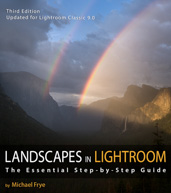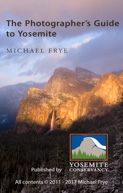Yosemite Photo Conditions
by Michael Frye | Aug 29, 2023 | Light and Weather, Yosemite Photo Conditions
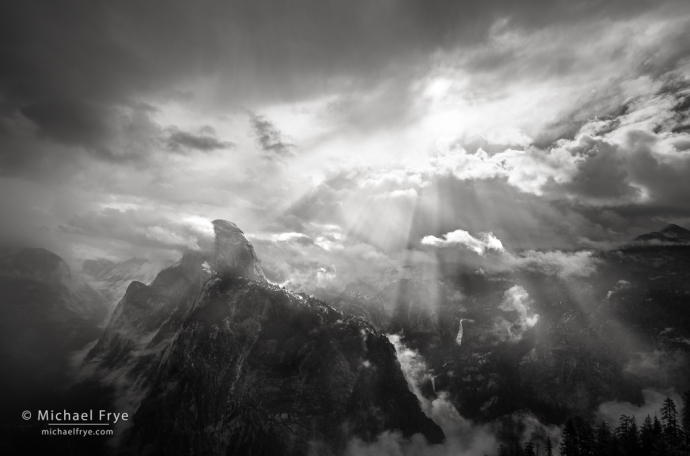
Sunbeams, Half Dome, and Nevada Fall from Glacier Point, Yosemite NP, California
As the remnants of Tropical Storm Hilary moved through California, I looked for opportunities to photograph interesting weather. I thought we might get thunderstorms, which we did, especially as the first bands of moisture reached our area. But I wasn’t able to find a thunderstorm in the right position to photograph it. We did, however, get three-quarters of an inch of rain at our house from one thunderstorm.
Then, as this large weather system moved off to the north, I realized there might be a chance to photograph a clearing storm Monday morning (August 21st). It looked like the rain would end around sunrise in Yosemite; it was less clear whether the clouds would dissipate enough for the sun to break through that early.
(more…)
by Michael Frye | Jan 26, 2023 | Light and Weather, Yosemite Photo Conditions
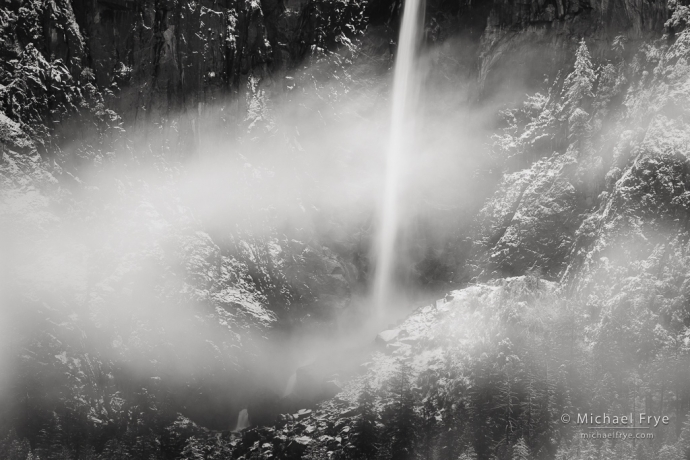
Mist, snow, and Bridalveil Fall, Yosemite NP, California
We had quite a series of storms in late December and early January. The Sierra foothills, where I live, didn’t suffer major flooding or mudslides, but there were lots of downed trees, power outages, and some washed-out roads.
Some nearby towns in the Central Valley, however, got some of the worst flooding in California. That includes Merced, which is about an hour’s drive from us, and Planada, a small town we regularly pass through on the way to Merced. The entire town of Planada was evacuated for two days earlier this month due to flooding.
(more…)
by Michael Frye | Apr 3, 2022 | Light and Weather, Yosemite Photo Conditions
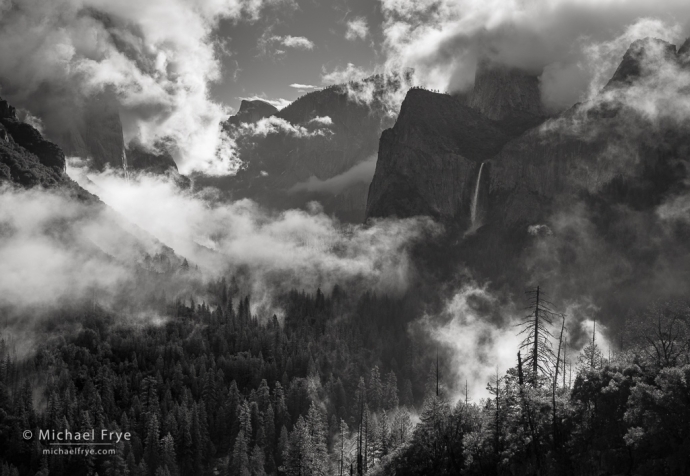
Half Dome and Bridalveil Fall during a clearing storm, Yosemite NP, California
Something rare happened last Tuesday: it rained. We’ve received very little rain here in the central Sierra since January 1st, but on Tuesday Yosemite Valley got .43 inches – not exactly a deluge, but something.
Claudia and I went up to Yosemite Valley on Tuesday afternoon, hoping to find some interesting light. We did see a faint rainbow at one point, but then clouds closed in, and it rained steadily until after sunset. We drove home in a downpour (and actually our town of Mariposa got more rain than Yosemite).
The next morning I rose early and drove out to the Merced River Canyon, hoping to find fog enveloping some of the late-blooming redbuds. But the fog and mist in the canyon hovered at least a couple hundred feet above the canyon floor – above redbud level – so I kept driving up to Yosemite Valley.
(more…)
by Michael Frye | Dec 21, 2021 | Light and Weather, Yosemite Photo Conditions
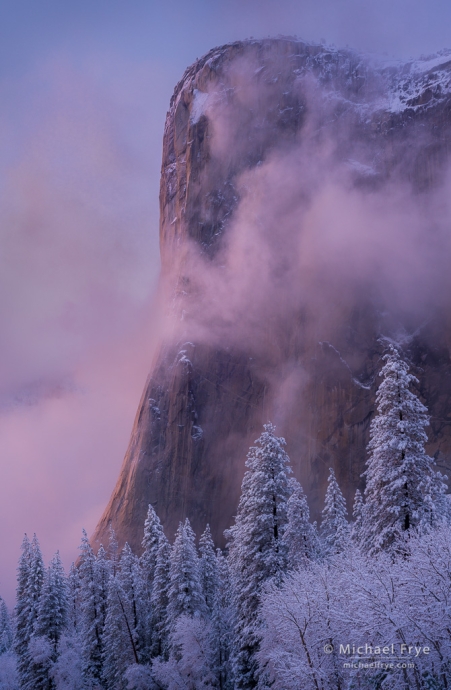
Pink light on El Capitan at sunset, Yosemite, last Tuesday evening. 50mm, 1/8 sec. at f/11, ISO 100.
We’ve reached the winter solstice in the Northern Hemisphere, and this year it actually feels like winter here in the Sierra Nevada. In some recent years the weather has been warm and dry in December – and that’s the way this month began. But last week two separate storms brought over five inches of precipitation to Yosemite Valley.
The first storm was the biggest. It rained hard in the Valley on Monday, but by Tuesday morning rain had changed to snow, eventually piling up about eight inches of white stuff. Our workshop group had to wait out some of that rain on Monday, but then we photographed almost all day Tuesday, with some brief breaks to dry out and warm up.
(more…)
by Michael Frye | May 9, 2021 | Yosemite Photo Conditions
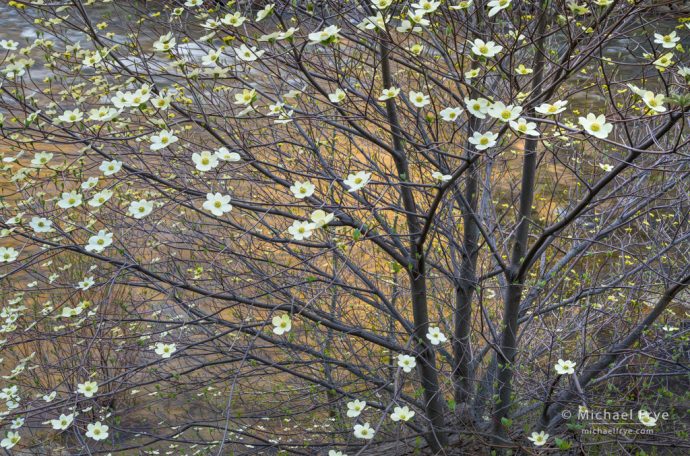
Dogwood above the Merced River, Yosemite. To find this composition I used my iPhone to “sketch” different possibilities. The composition I liked best required holding the phone high over my head, but luckily my tripod went high enough to put my Sony camera up there. 50mm, 1/3 sec. at f/16, ISO 100, focus stacked.
Despite the dry winter – or maybe because of it – it’s been a good year for dogwoods. These things always vary, of course, because that’s the way nature works. The relationships between plants and their environment is incredibly complex. Weather is a big factor, including moisture, temperature, and sunlight. But every plant is affected by soil, by microorganisms in the soil, by animals (especially insects) that want to feed on it, by animals that feed on the animals that want to feed on it, by animals that might pollinate its flowers, and by neighboring plants it competes with, or, sometimes, cooperates with. And the way each plant responds to all those factors is influenced by its own genetics.
Which is to say that not every dogwood lives under the same conditions, and even if they did, they wouldn’t all respond to those conditions in the same way. So when I say that it’s been a good year for dogwoods, it would be more accurate to say that it’s been a good year for many dogwoods, though not all. Some have produced average or below-average blooms. But this year many dogwoods have produced above-average blooms. Some are incredibly full, to the point where it’s hard to imagine where another blossom would fit.
(more…)
by Michael Frye | Feb 21, 2021 | Light and Weather, Yosemite Photo Conditions
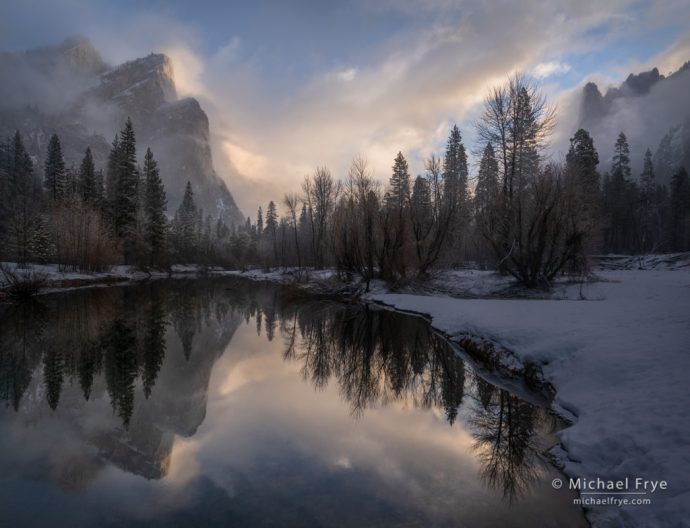
Three Brothers, Sentinel Rock, and the Merced River at sunrise, Yosemite. On Saturday morning the sun broke through the clouds just after sunrise to light the Three Brothers. 19mm, 1/20 sec. at f/11, ISO 100.
Aside from one big storm in late January, it’s been another dry winter here in central California. So any forecast for precipitation – even a small amount – piques my interest.
On Monday Yosemite Valley got two-tenths of an inch of rain, then another two-tenths early Saturday morning. That’s pretty meager, and often such small storms don’t add enough moisture to the atmosphere to generate any mist. But surprisingly, both of these small systems created lots of mist in the valley.
(more…)













